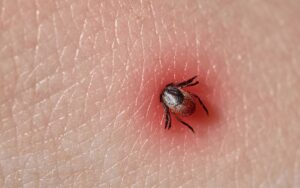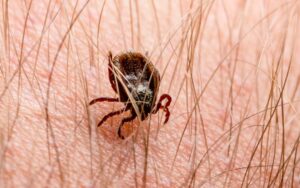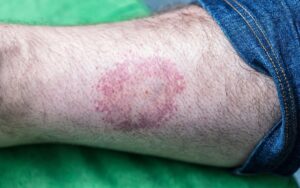Understanding the Complexities of Lyme Disease
May is Lyme Disease Awareness Month. This month, we aim to raise awareness and increase education about this serious and growing disease. May is also the month when ticks, the source of Lyme Disease, become active again in many parts of the United States. We’re here to give you the information you need to know, the symptoms to look for, tips for prevention, and a new, cost-effective approach to your healthcare if Lyme strikes someone in your family.
What is Lyme Disease? 
Lyme Disease is caused by the bite of a black-legged tick (also known as a deer tick) carrying Borrelia bacteria. While ticks can be found just about anywhere in the US, they are most commonly found in the upper midwestern states and the northeastern and mid-Atlantic states. They tend to be most active in the spring, summer, and fall.
Lyme Disease can occur when you are bitten by an infected tick. The Lyme-causing bacteria can be transmitted to its host in about 24 hours, though many researchers have debated whether it may be sooner than that. It is crucial to remove a tick immediately if you find one. Make sure you use the proper method to remove it completely, ensuring none of its parts are left behind.
Identifying a Tick Bite

However, detecting a tick bite can also be extremely difficult. Some ticks are so tiny that they are barely visible unless you look for them. If the tick falls off before you see it or is well-hidden on your body, a tick bite can easily be overlooked or mistaken for another insect’s bite. Often, when diagnosed with Lyme Disease, many don’t even remember a tick bite.
What makes the identification of Lyme Disease so tricky is that symptoms easily mimic other diseases. It is common for a person to be misdiagnosed with multiple sclerosis, arthritis, chronic fatigue syndrome, or lupus because of how similar the symptoms are.
Additionally, early Lyme lab tests can be imperfect, providing false results to some. Labs often will not detect Lyme Disease positively for six weeks, leading to many misdiagnosed symptoms.
What are the Symptoms of Lyme Disease?
According to the Global Lyme Alliance, the symptoms of Lyme Disease come in stages. An early diagnosis of Lyme can greatly improve symptoms. Symptoms can vary significantly from person to person. Over a hundred different symptoms have been recorded, making Lyme even more difficult to diagnose.
Stage 1
At the early stage of Lyme Disease, the symptoms are acute (or localized) because the bacteria has not yet spread far. This stage can begin days or weeks after the bite. Here is what you might expect to find during the early stage:
- A bullseye rash at the tick bite
- A rash on other parts of the body
- Fever
- Fatigue
- Aches
- Chills
- Swollen lymph nodes
- Flu-like symptoms
Stage 2
The next stage of Lyme Disease, though different for each person, happens weeks to months after the infected bite. The bacteria has started to spread a little further than in Stage 1. Symptoms can range from any of the following:
- Extreme headaches
- Neck stiffness
- Lyme Arthritis (in larger joints)
- Muscle pain
- Heart palpitations or shortness of breath (known as Lyme carditis)
- Facial paralysis (known as Bell’s palsy)
- Numbness/tingling in the hands or feet
- Severe fatigue
Stage 3
Late Stage Lyme Disease occurs months to years after the initial bite. At this point, the bacteria has fully spread throughout the body. The symptoms now are similar to those in Stage 2 but may be more severe and longer lasting. Additional symptoms may also include:
- Neurologic or cognitive impairment (such as vertigo)
- Memory impairment
- Insomnia
- Brain-fog
- Difficulty processing information (such as having conversations with others)
Lyme Disease Prevention
If you are intentional about preventing ticks, you can reduce your chances of contracting Lyme Disease. During tick season, check your body, clothing, and pets regularly for ticks, especially after spending time outdoors in wooded or grassy areas. Ticks are most active in spring, summer, and fall. They like to crawl once they are on your body, so checking your entire body is crucial. They can be in hidden places like underarms, behind ears, belly buttons, and hair. Pets can unknowingly bring them into your home, too.
If you regularly spend time outdoors, use a tick repellant. There are powerful repellants registered with the Environmental Protection Agency that are very effective (just avoid spraying your face, and do not use repellants on children aged three or under). Removing your clothing and running it in a hot dryer for 10 minutes is a good idea to kill any possible ticks.
To prevent ticks from infesting your yard, you can hire professionals to apply repellent to your lawn, ensuring they stay far away from your home. Chickens or guineafowl can be a great addition to your yard and are known to be excellent at tick control.
Consider scents like lemon eucalyptus, rosemary, cedar, lemongrass, peppermint, citronella, and geranium if you prefer a natural tick repellent.
How can Lyme Disease be Treated?
Lyme Disease is not always simple to treat. Multiple treatments are often needed for a patient to go into remission. Treatment can differ significantly from person to person; what works for one might not work for another. It also depends on the stage of the disease, its severity, the age of the patient, and other factors. Most importantly, you should consult with a Lyme Physician who can help you with a diagnosis and treatment plan. Untreated Lyme Disease can spread to other body parts, leading to nervous system complications. Here are a few of the options that patients might look into with their physician:
Antibiotics – A 2-3 week antibiotic course is the most common treatment for early-stage Lyme Disease. Antibiotics are also used to treat later-stage Lyme but for longer courses. Intravenous antibiotics may be used for later-stage Lyme Disease.
Herbal Therapy—Some people choose to use herbs with antimicrobial properties. This can be a safe and non-toxic approach to alleviating Lyme Disease symptoms. Herbs can be a great alternative to long-term antibiotic use.
Lifestyle- Maintaining a healthy diet, exercising regularly, and reducing stress have been known to keep Lyme Disease symptoms at bay by optimizing the immune system.
Other Holistic Treatments – There are so many different treatment options that it would be hard to name them all. Because everyone responds differently to treatments, it’s tough to determine which are the most effective. That is a conversation to have with your physician. Some of the options for holistic treatments are:
- Ozone Therapy
- Whole Body Hyperthermia
- Hyperbaric Oxygen Therapy
- Ultraviolet Blood Irradiation
- Peptides
- IV Therapy
- Detoxification
- And more
How Can Knew Health Support You
One of the reasons so many are choosing Knew Health is the reassurance and confidence it provides in healthcare choices when diagnosed with a new illness such as Lyme Disease. Members can opt for treatment from conventional or naturopath doctors, empowering them to make decisions that best support their wellness.
Knew Health also offers a straightforward and cost-effective lab process. Members can get answers quickly, enhancing their confidence in their health management. If you ever have questions about how we can help you optimize your health and wellness through labwork, herbal supplements, diagnosing new illnesses, or preventive healthcare, we encourage you to speak with a member of our care team or email us with your questions. With Knew Health on your side, let Lyme disease be a hurdle, not a roadblock, on your journey to living well.
Disclaimer: This information is being provided to you for educational and informational purposes only. It is being provided to educate you about how to take care of your body and as a self-help tool for your own use so that you can reach your own health goals. It is not intended to treat or cure any specific illness and is not to replace the guidance provided by your own medical practitioner. This information is to be used at your own risk based on your own judgment. If you suspect you have a medical problem, we urge you to take appropriate action by seeking medical attention.
Sources
“About Lyme Disease.” Global Lyme Alliance, www.globallymealliance.org/about-lyme/.
“Lyme Disease.” Mayo Clinic, 10 Feb. 2023, www.mayoclinic.org/diseases-conditions/lyme-disease/symptoms-causes/syc-20374651.
“Lyme Disease Symptoms.” Global Lyme Alliance, www.globallymealliance.org/about-lyme/diagnosis/symptoms/.
Rawls, Bill MD. “My Chronic Lyme Disease Journey.” Rawls MD, 22 Jul. 2022, rawlsmd.com/health-articles/my-chronic-lyme-disease-journey.

















































